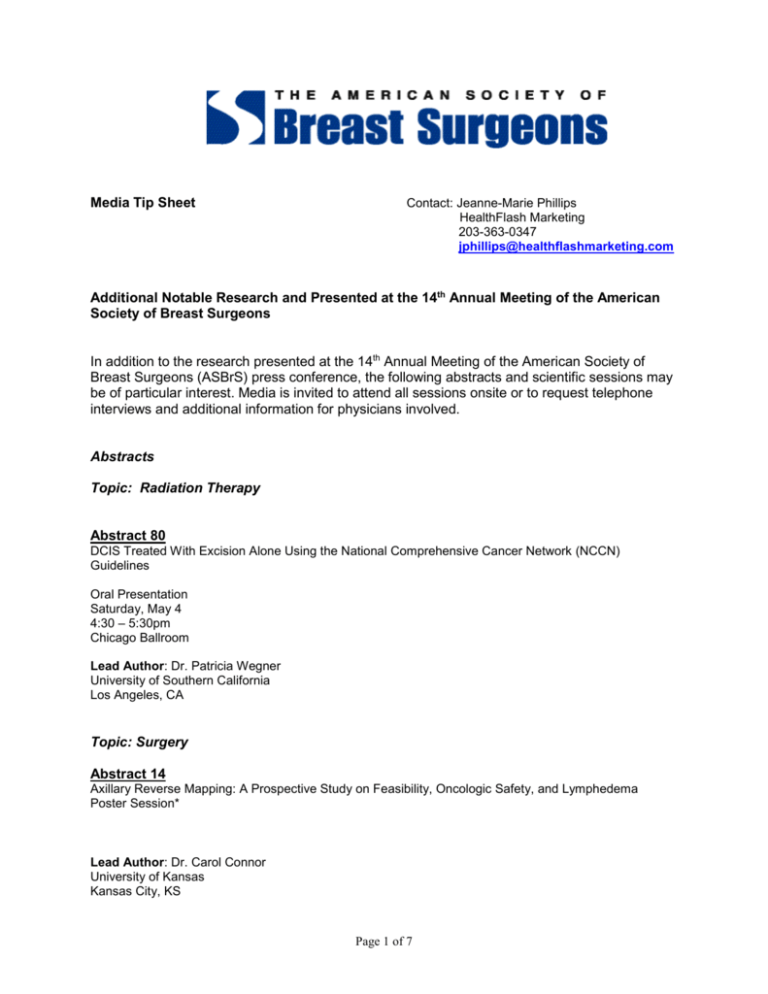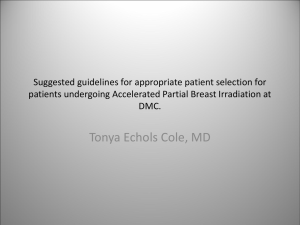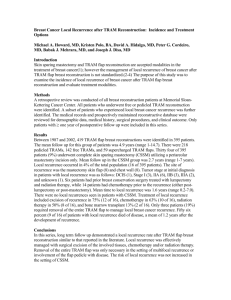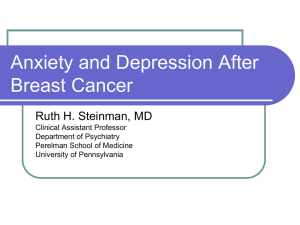MS-Word - American Society of Breast Surgeons
advertisement

Media Tip Sheet Contact: Jeanne-Marie Phillips HealthFlash Marketing 203-363-0347 jphillips@healthflashmarketing.com Additional Notable Research and Presented at the 14th Annual Meeting of the American Society of Breast Surgeons In addition to the research presented at the 14th Annual Meeting of the American Society of Breast Surgeons (ASBrS) press conference, the following abstracts and scientific sessions may be of particular interest. Media is invited to attend all sessions onsite or to request telephone interviews and additional information for physicians involved. Abstracts Topic: Radiation Therapy Abstract 80 DCIS Treated With Excision Alone Using the National Comprehensive Cancer Network (NCCN) Guidelines Oral Presentation Saturday, May 4 4:30 – 5:30pm Chicago Ballroom Lead Author: Dr. Patricia Wegner University of Southern California Los Angeles, CA Topic: Surgery Abstract 14 Axillary Reverse Mapping: A Prospective Study on Feasibility, Oncologic Safety, and Lymphedema Poster Session* Lead Author: Dr. Carol Connor University of Kansas Kansas City, KS Page 1 of 7 Abstract 142 Immediate Breast Reconstruction After Surgery for Breast Cancer: A Retrospective Review of Cancer Quality Initiatives (CQI) at a Public, Academic, and University-Owned Private Hospital in a Metropolitan Area Poster Session* Lead Author: Dr. Erin Bowman Emory University School of Medicine Atlanta, GA Topic: Metastasis/Triple Negative Disease Abstract 129 Breast Cancer Biomarker Discordance Between Primary and Sites of Metastasis – A Systematic Review Poster Session* Lead Author: Dr. IC Yeung The Ottawa Hospital and the University of Ottawa Ottawa, Canada Abstract 107 Predictive Factors and Patterns of Recurrence in Patients With Triple-Negative Breast Cancer Poster Session* Lead Author: Dr. Lauren Steward Washington University School of Medicine St. Louis, MO *Scientific Poster Session and Reception: Location: Chicago Ballroom 8-10, 6:00-7:30pm, Friday, May 3 ATTRIBUTION TO THE 14th ANNUAL MEETING OF THE AMERICAN SOCIETY OF BREAST SURGEONS IS REQUESTED IN ALL COVERAGE. Page 2 of 7 80. DCIS Treated With Excision Alone Using the National Comprehensive Cancer Network (NCCN) Guidelines Patricia Wehner1, Katherine Kopkash1, Amanda Woodworth1, Melvin Silverstein1,2 1University of Southern California, Los Angeles, CA, USA, 2Hoag Hospital, Newport Beach, CA, USA Objectives: Until recently, most patients with DCIS were treated with mastectomy or excision followed by radiation therapy. In 2008, the NCCN published guidelines stating, “If the patient and physician view the individual risk as ‘low,’ some patients may be treated by excision alone.” The NCCN stated that factors that may determine local recurrence risk are palpable mass, larger size, higher grade, close or involved margins, and age under 50 years. The goal of this study is to determine local and distant recurrence and breast-cancer specific survival in patients with DCIS treated with excision alone. Method: A prospective, single-institution database was analyzed for patients who met the NCCN guidelines for treatment of DCIS by excision alone. We used the following inclusion criteria: pure ductal carcinoma in situ (no microinvasion), tumor extent 20 mm or less, age equal or greater than 50 years, margin width equal or greater than 2 mm, and nuclear grade 1 or 2 (non-high grade). All patients were treated with excision alone. No adjuvant hormonal, systemic, or radiation therapy was used in conjunction with surgery. Kaplan-Meier analysis was used to determine recurrence and survival rates. Results: Number of patients 204 Average time of followup Average disease size Number of ipsilateral invasive recurrences Number of ipsilateral DCIS recurrences Number of distant recurrence 6-year local recurrence rate 12-year local recurrence rate 12-year breast cancer-specific survival 67 mo 9.4 mm 4 5 1 6.6% 7.8% 100% Conclusions: The 12-year local recurrence rate for DCIS patients in NSABP Protocol B-17 treated with excision alone was 32%, and for excision plus radiation therapy, was 16%. In this study, retrospectively using the NCCN Guidelines to our patients, the 12-year local recurrence rate for excision alone was 7.8%. If radiation therapy had been added to our treatment plan, the recurrence rate would have dropped by 50% to 3-4%. One hundred patients were to have been irradiated, 96 would have received no benefit. Radiation therapy is time consuming and has side effects. Should mastectomy have to be performed in the future, reconstruction will be compromised. Patients with a low risk of local recurrence, if treated by excision alone, can be safely selected using the NCCN Guidelines. Should a patient recur after excision alone, re-excision and radiation therapy can be used at the time of recurrence. Page 3 of 7 14. Axillary Reverse Mapping: A Prospective Study on Feasibility, Oncologic Safety, and Lymphedema Carol Connor, Marilee McGinness, Joshua Mammen, Jennifer Klemp, Lori Ranallo, Stephanie LaFever, Fang Fan, Jonathan Mahnken University of Kansas, Kansas City, KS, USA Objectives: Determine the feasibility, oncologic safety, and lymphedema outcomes in patients treated with axillary reverse mapping (ARM). Method: This is a prospective single-institution study of 184 patients (28 bilateral, 212 procedures) with ARM at the time of SLNB or ALND between December 2009 and February 2012. One hundred fifty-four had SLNB alone (group 1) and 58 had ALND with or without SLNB (group 2). Blue dye was injected into the upper inner arm for arm lymphatic identification if radioisotope SLN localization was confirmed preoperatively with gamma probe evaluation. In group 1, preservation of the blue lymphatic/node was attempted unless it was an SLN. In group 2, preservation was attempted if the blue/node lymphatic was outside the boundaries of a standard ALND. Lymphedema was assessed by circumferential arm measurements. An increase of 2 cm at any level compared to baseline was considered positive for lymphedema. Results: No patient experienced a systemic reaction to blue dye injection. Superficial skin necrosis occurred in 1 patient at the arm injection site. A blue lymphatic/node was identified in 47% (73/154) of Group 1 and in 71% (41/58) of group 2. SLNB was performed in 197 procedures (154/154 in group 1 and 43/58 in group 2). SLN identification was 100% (154/154) in group 1 and 98% (42/43) in group 2. A blue node was also an SLN (crossover) in 11% (22/197) of procedures with an SLN identified: 12% (18/154) of group 1 and 10% (4/42) of group 2. Arm lymphatic preservation was successful in 83% (38/46) of eligible group 1 procedures and 100% (7/7) of eligible group 2 procedures. One blue SLN and 2 blue non-SLNs were positive for malignancy. One blue/hot SLN was negative for malignancy at ALND, but contained the clip from a positive axillary core needle biopsy (CNB). All positive blue nodes occurred in neoadjuvant patients with a positive axillary CNB at diagnosis. None of the blue nodes in clinically node-negative patients were positive for disease. One-year lymphedema results were available for 137 SLN only and 46 ALND procedures. Lymphedema occurred in 9 patients (3 bilateral, 12 procedures): 4% (6/137) of SLN-only procedures and 13% (6/46) of ALNDs. One patient in group 1 and 1 patient in group 2 with arm lymphatic preservation developed lymphedema. Conclusions: ARM is feasible with minimal morbidity. Crossover between arm and breast lymph nodes occurred in 11% of patients. The finding of disease in sentinel and non-sentinel blue (ARM) nodes in neoadjuvant patients with a positive axilla at diagnosis raises concerns over the oncologic safety of ARM in this setting. No blue nodes were positive in patients with a clinically negative axilla at diagnosis. Evaluation of this technique in a larger sample of early-stage patients is needed to confirm the oncologic safety of blue arm node preservation in clinically node-negative patients. Page 4 of 7 142. Immediate Breast Reconstruction After Surgery for Breast Cancer: A Retrospective Review of Cancer Quality Initiatives (CQI) at a Public, Academic, and University-Owned Private Hospital in a Metropolitan Area Erin Bowman1, Ritam Chowdhury1, Angela Cheng1, Monica Rizzo1, Grant Carlson1, Albert Losken1, Joel Okoli2, Sheryl Gabram-Mendola1 1Emory University School of Medicine, Atlanta, GA, USA, 2Morehouse School of Medicine, Atlanta, GA, USA Objectives: In 2009, the National Accreditation Program for Breast Centers (NAPBC) added the audit filter that all appropriate patients undergoing mastectomy for breast cancer are offered immediate reconstruction and is monitored for compliance annually. Postmastectomy breast reconstruction improves psychological well being, as well as cosmetic results. The aim of this study is to determine if there are existing disparities in postmastectomy breast reconstruction among 3 hospitals in a metropolitan area. Method: A retrospective chart review was done from January 1, 2010, to December 31, 2011, during the CQI audit to identify patients who underwent mastectomy for breast cancer treatment in a public, academic, and university-owned private hospital. All 3 hospitals have breast providers within the same healthcare system. Other covariates identified included the rate of immediate reconstruction, socio-economic status, insurance status, race, age, stage of cancer, and radiotherapy (a relative contraindication to immediate reconstruction). SAS 9.3 was used to conduct chi-square tests and univariate logistic regression to identify patterns of association. Results: All patients’ medical records from 2010-2011 were reviewed retrospectively and identified 75 patients who underwent mastectomy for breast cancer treatment in the public hospital, 261 patients in the academic hospital, and 267 patients in the university-owned private hospital. Twenty-four percent (18/75) in the public hospital, 54% (162/261) at the academic institution, and 35% (93/267) at the university-owned private hospital underwent immediate postmastectomy breast reconstruction (<0.0001). Eighty-three percent (62/75) of patients treated in the public hospital, 26% (67/261) in the academic hospital, and 76% (204/267) at the universityowned private hospital were African American women (<0.0001). There were significant differences in socioeconomic and insurance status for patients in these settings, with Medicaid covering 76% (60/75) in the public hospital, 11% (29/261) in the academic hospital, and 15% (39/267) in the university-owned, private hospital (p < 0.0001). Radiation therapy was administered in 46% (35/75) in the public hospital, 31% (82/267) in the academic hospital, and 23% (59/261) in the university-owned, private institution (p < 0.002). We found significantly higher odds of immediate postmastectomy reconstruction at the academic hospital (OR = 3.78; 95% CI, 2.11-6.77), but not at the university-owned, private hospital (OR = 1.69; 95% CI, 0.94-3.04), as compared to the public hospital. Conclusions: This retrospective study shows that disparities may exist in the public hospital with respect to immediate breast reconstruction. Although many of the physicians who work at these 3 hospitals overlapped considerably and participate in multidisciplinary conferences, we found that disparities exist in spite of this. Direct correlation to race and financial status exist in these settings, with an increased number of patients undergoing immediate breast reconstruction when the patient population is composed of nonminorities, with private insurance, and treated in an academic and not a public hospital. This study provides additional data to the existing literature by comparing 3 distinct settings within the same healthcare system in a metropolitan area. Given the identified barriers to reconstruction following breast cancer surgery, our next step is to intervene and alter current practices to eliminate differences in medical treatment among different patient populations. Page 5 of 7 129. Breast Cancer Biomarker Discordance Between Primary and Sites of Metastasis – A Systematic Review IC Yeung1, MJ Clemons1, C Addison1, B Hutton1,2, X Zhu1, A Arnaout1 1The Ottawa Hospital and the University of Ottawa, Ottawa, Canada, 2Ottawa Hospital Research Institute, Ottawa, Canada Objectives: Systemic treatment choices for breast cancer patients with recurrent disease are usually based on the ER/PR/HER2 biomarker status of the primary cancer. Biomarker discordance between the primary and metastatic sites is well recognized and could have important therapeutic implications. A systematic review was conducted to assess the extent of biomarker discordance between the primary cancer and metastasis, and whether is influenced by the site of metastasis. Method: An electronic search of multiple literature databases implemented by an information scientist was conducted to identify studies reporting outcomes of ER/PR/HER2 receptor stability between primary site and recurrent disease. Two reviewers independently screened the abstracts and full text articles, which were identified according to pre-defined selection criteria. The same reviewers performed data collection from all included studies. Studies that were identified reported on receptor conversion between primary sites of breast cancer and various sites of metastasis, including lymph node, liver, brain, lung, skin, GI sites, and bone marrow. Results: Preliminary results from eligible studies consistently demonstrated discordance between the primary and metastatic sites. When discordance occurred, the general trend was for loss of hormone receptor. ER hormone status was more stable (discordance, 10.2-32.5%) than PR (discordance, 25.5-40.7%). HER2 was found to have lower rates of discordance (2.6-14.5%). In general, higher ER/PR discordance was found in bone (40-68%) and liver (0-54%) when compared to other sites, including brain (36%), lung (9-18%), skin (6-22%), and GI (15-40%). In a prospective study, biomarker discordance led to change in patient management in up to 20% of the patient population. Conclusions: Our results demonstrate that biomarker discordance between primary and distant metastases does occur in breast cancer and occurs more frequently with PR, and the extent of discordance is influenced by the site of metastasis. Further research is required to have a better explanation about the pathophysiology of the biomarker status change and its clinical implications. Page 6 of 7 107. Predictive Factors and Patterns of Recurrence in Patients With TripleNegative Breast Cancer Lauren Steward, Leah Conant, Feng Gao, Julie A Margenthaler Washington University School of Medicine, St. Louis, MO, USA Objectives: Triple-negative breast cancer [(TNBC) = estrogen receptor (ER) negative, progesterone receptor (PR) negative, and Her2 nonamplified] is a unique subtype of breast cancer that generally portends a poorer prognosis. We sought to describe the outcomes of patients with TNBC in order to determine the patterns of recurrence, time to recurrence, and the impact on overall survival. In addition, we investigated whether certain patient and/or tumor factors were predictive of recurrence. Method: We retrospectively reviewed our prospectively maintained database and identified 484 patients with initial stage I-III TNBC who were treated between January 2002 and December 2009. Data included patient and tumor characteristics; surgical, systemic, and radiation treatment received; and breast cancer-specific survival. Patients were divided according to whether or not they experienced a recurrence (either local or distant or both). Data were compared using chi-square, Fisher exact test, and logistic regression. A p value <0.05 was considered significant. Results: The study cohort included 484 patients with a mean age of 53.3 + 12.6 years and a mean follow-up of 29 + 21 months. Of 484 patients, 349 (72%) had no evidence of recurrence while 135 (28%) had recurrent disease, including 26 (19%) with locoregional recurrence, 76 (56%) with distant recurrence, and 33 (24%) with both locoregional and distant recurrence. Of the 59 total locoregional recurrences, 23 (39%) were in the ipsilateral regional nodes, 23 (39%) in the ipsilateral breast, and 13 (22%) in the chest wall post-mastectomy. Of the 109 patients with distant recurrences, lung was the most common site (n = 58) followed by bone (n = 49), liver (n = 48), and brain (n = 40). The mean time from completion of curative-intent therapy to disease progression was 21 months (range, 6 weeks–56 months); there was no difference in disease-free survival interval between those patients experiencing a locoregional recurrence only vs those with distant recurrence only or distant and locoregional recurrence (p > 0.05). Factors significantly associated with recurrence included race (African American & other), increasing tumor size, positive pathologic nodal status, increasing stage, and type of surgical therapy (mastectomy) (p < 0.05 for each). Age, tumor grade, histology, receipt of radiation, and timing of chemotherapy were not significantly associated with recurrence (p > .05). After controlling for all potential confounders in multivariate stepwise regression, only race and increasing pathologic stage were independent predictors of recurrence (p < 0.05 for each). At study follow-up, only 7 (5%) of the 135 total patients with recurrence were alive. Conclusions: Nearly 30% of all patients with a TNBC experienced either a locoregional and/or distant recurrence, and African-American patients were at the highest risk. The onset of disease progression was within 3 years for 90% of patients who recurred. Although bone metastases were common in patients with TNBC, they were more likely to occur with visceral metastases as well. Locoregional and/or systemic recurrence in our cohort of patients with TNBC resulted in 95% breast cancer-specific mortality. The lack of targeted therapy for this aggressive breast cancer subtype likely contributed to this finding. Page 7 of 7






